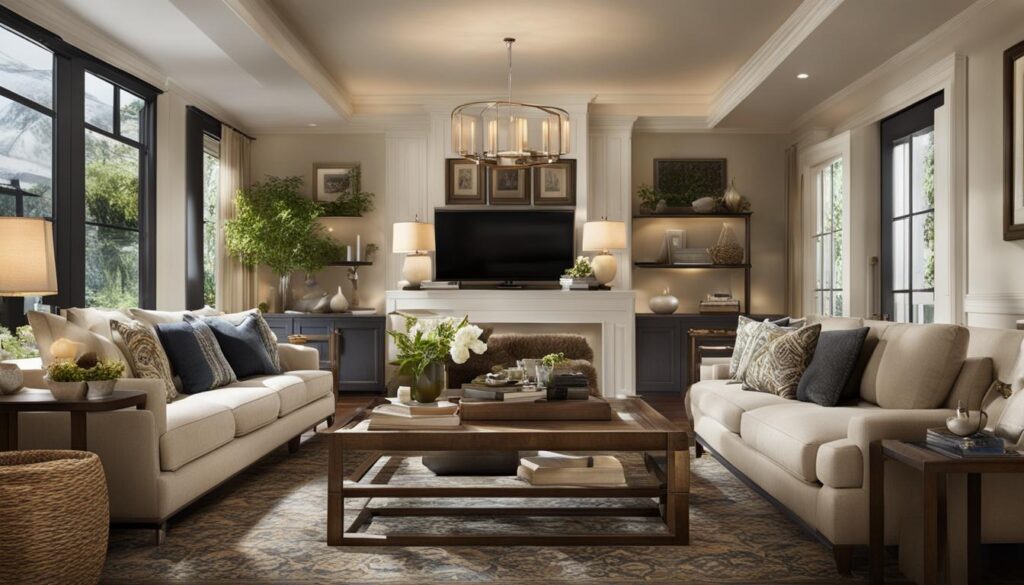Arranging furniture in a living room requires careful consideration of the room’s shape and purpose. It’s important to create a layout that is both functional and aesthetically pleasing. In this article, I will provide you with expert tips and ideas to help you arrange your furniture in a way that maximizes space, creates a cozy atmosphere, and enhances the overall design of your living room.
Table of Contents
Key Takeaways:
- Start by positioning the largest piece of furniture, such as the sofa, facing the room’s focal point.
- Add smaller seating options, such as chairs or love seats, opposite or adjacent to the main piece.
- Fill in the space with accent furniture like ottomans, coffee tables, end tables, and lamps.
- Consider flexible arrangements that can be adjusted for different occasions.
- Use a large area rug to unify the seating group within a larger space.
Tips for Arranging Furniture in a Small Living Room
Arranging furniture in a small living room can be a challenge, but with some strategic thinking, you can create a cozy and functional space. Here are some tips to help you make the most of your small living room:
- Avoid pushing all the furniture against the walls. Instead, pull the furniture towards the center of the room to create a more open and inviting space.
- Use lightweight chairs that can be easily moved into the sitting area if needed. Consider pieces like ottomans or stools that can serve as side tables or extra seating.
- Choose a furniture layout that facilitates conversation if the room is frequently used for chats with family and friends. Pull the seating pieces close to the middle of the room and position them to face each other, with a coffee table in the center for easy drink access.
- Be creative with space-saving options, such as sectionals, armchairs, or stools, and utilize corner areas with lightweight chairs or storage ottomans.
- Think outside the box and consider diagonal furniture arrangements for added dimension and a welcoming pathway into the seating group.
Remember, the key is to maximize the available space and create a layout that suits your needs while maintaining a visually appealing aesthetic. Don’t be afraid to experiment with different arrangements until you find the perfect setup for your small living room.
To illustrate these tips, here’s a table showcasing two different furniture arrangements for a small living room:
| Arrangement Option 1 | Arrangement Option 2 |
|---|---|
| In this arrangement, the sofa is positioned against the wall, with two lightweight chairs angled towards it. A small coffee table sits in the center, providing a surface for drinks and snacks. | In this arrangement, a sectional sofa is placed against one wall, creating a cozy seating area. A storage ottoman acts as a coffee table and provides additional seating when needed. |
 |  |
Best Practices for Furniture Arrangement in a Living Room with a TV
Arranging furniture in a living room with a TV requires careful consideration to create a functional and aesthetically pleasing layout. Start by identifying the natural focal point of the room, whether it’s a fireplace, a set of windows, or the TV itself. Once you’ve determined the focal point, orient the seating towards it to enhance the viewing experience.
Creating zones within the room can help maximize its functionality. Consider dedicating separate areas for activities such as game-playing, reading, or lounging. This allows for a versatile space that caters to different needs and preferences.
When it comes to furniture placement, various layouts work well for living rooms with TVs. Symmetrical layouts, floating layouts, and L-shaped layouts are popular options, depending on the available space and furniture placement possibilities. It’s important to ensure that the TV is not affected by sunlight or glare, so position it in a way that minimizes these issues while facing the seating area.
Another consideration is traffic flow. Make sure there are clear paths between furniture pieces to avoid any obstructions. Balance the size and placement of furniture and accessories for a visually pleasing arrangement, and anchor seating groups with area rugs. Adequate lighting is essential, so incorporate a mix of overhead lighting, floor lamps, and table lamps to ensure a well-lit and inviting ambiance.
FAQ
How should I arrange furniture in a living room?
When arranging furniture in a living room, start by positioning the largest piece, such as the sofa, facing the room’s focal point. Add smaller seating options opposite or adjacent to the main piece and fill in the space with accent furniture. Use a large area rug to unify the seating group and consider flexible arrangements. For long or large living rooms, divide the space into two conversation groupings. Aim for a symmetrical or balanced look whenever possible.
What should I do when dealing with a small living room?
In a small living room, avoid pushing all the furniture against the walls. Instead, pull the furniture towards the center of the room to create a more open and inviting space. Use lightweight chairs that can be easily moved, and consider pieces like ottomans or stools for side tables or extra seating. Choose a furniture layout that facilitates conversation and utilize corner areas with lightweight chairs or storage ottomans. Consider diagonal furniture arrangements for added dimension.
How do I arrange furniture in a living room with a TV?
When arranging furniture in a living room with a TV, orient the seating towards the focal point and create zones for different activities. Symmetrical layouts, floating layouts, and L-shaped layouts are popular options. Ensure that the TV is not affected by sunlight or glare and that it is positioned facing the seating area. Consider mounting the TV above the fireplace for a small living room layout. Pay attention to traffic flow and lighting, and plan ahead by sketching out your desired floor plan.


